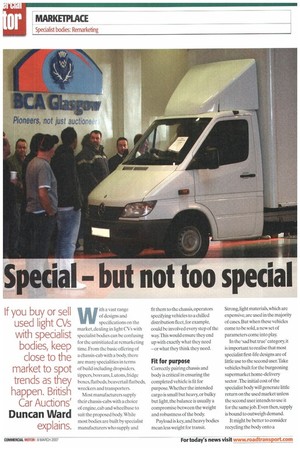Special but not too special
Page 66

Page 67

If you've noticed an error in this article please click here to report it so we can fix it.
if you buy or sell used light CVs with specialist bodies, keep close to the market to spot trends as they happen. British Car Auctions' Duncan Ward explains.
With a vast range of designs and specifications on the market, dealing in light CVs with specialist bodies can be confusing for the uninitiated at remarketing time. From the basic offering of a chassis-cab with a body, there are many specialities in terms of build including dropsiders, tippers, bmvans, Lutons, fridge boxes, flatbeds, beavertail flatbeds, wreckers and transporters.
Most manufacturers supply their chassis-cabs with a choice of engine, cab and wheelbase to suit the proposed body. While most bodies are built by specialist manufacturers who supply and fit them to the chassis,operators specifying vehicles to a chilled distribution fleet,for example, could be involved every step of the way.This would ensure they end up with exactly what they need or what they think they need.
Fit for purpose
Correctly pairing chassis and body is critical in ensuring the completed vehicle is fit for purpose. Whether the intended cargo is small but heavy, or bulky but light, the balance is usually a compromise between the weight and robustness of the body.
Payload is key, and heavy bodies mean less weight for transit. Strong, light materials, which are expensive, are used in the majority of cases. But when these vehicles come to be sold, a new set of parameters come into play.
In the 'sad but true' category, it is important to realise that most specialist first-life designs are of little use to the second user.Take vehicles built for the burgeoning supermarket home-delivery sector .The initial cost of the specialist body will generate little return on the used market unless the second user intends to use it for the same job. Even then,supply is bound to outweigh demand.
It might be better to consider recycling the body onto a new chassis, giving it a second working life and perhaps saving some money at the front end. The redundant vehicle can be remarketed as a chassis-cab for the second user to fit the body of his choice.
Even if the original body is to be scrapped, it might be worth removing because a chassis-cab could fetch a higher price.A word of warning, however: if this is a route you plan to take, move quidkly. Used CVs depreciate from day one, so don't end up losing any potential benefit through procrastination.
Compared with the huge volume of standard panel vans, bodybuilt light CVs are rare, making them relatively desirable. So what do used buyers want? No surprises here — the same rules apply as for every other CV.
Buyers care more about condition than which manufacturer provided the chassis-cab.A clean body on an equally clean, low-mileage chassis-cab will sell for top dollar, but don't expect premium brands with the 'right' badge on the grille to save the day if the whole package is in poor condition.
After condition, buyers look for pedigree (who has owned it). history and documentation.., all the usual suspects. •






















































































































































































